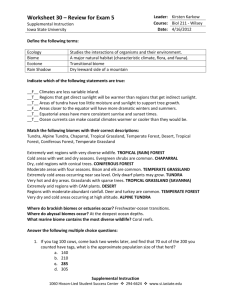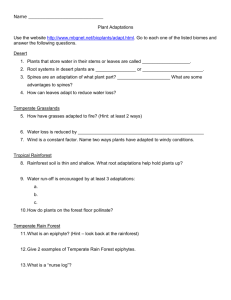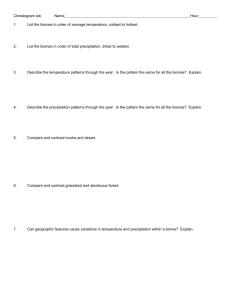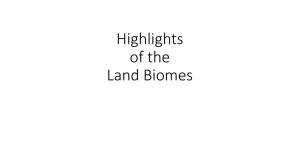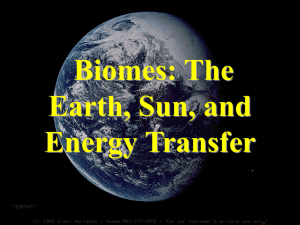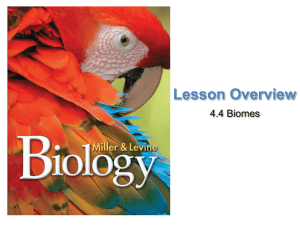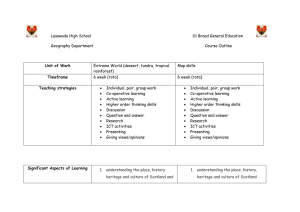Animals of the temperate forest
advertisement
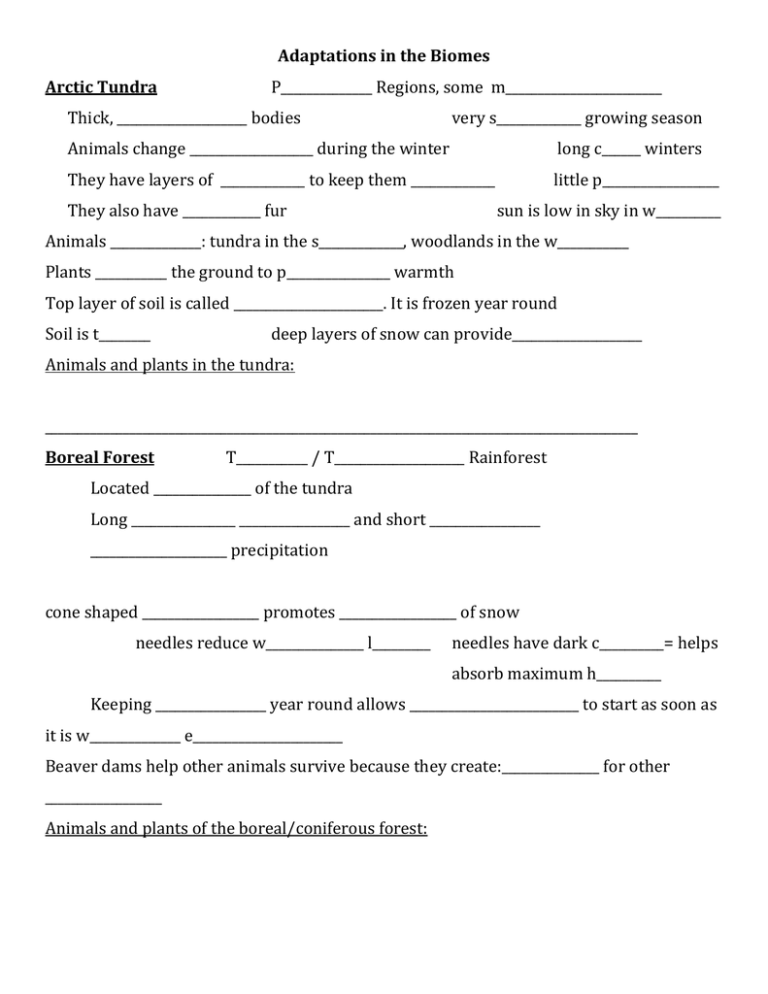
Adaptations in the Biomes Arctic Tundra P______________ Regions, some m________________________ Thick, ____________________ bodies very s_____________ growing season Animals change ___________________ during the winter long c______ winters They have layers of _____________ to keep them _____________ little p__________________ They also have ____________ fur sun is low in sky in w__________ Animals ______________: tundra in the s_____________, woodlands in the w___________ Plants ___________ the ground to p________________ warmth Top layer of soil is called _______________________. It is frozen year round Soil is t________ deep layers of snow can provide____________________ Animals and plants in the tundra: ___________________________________________________________________________________________ Boreal Forest T___________ / T____________________ Rainforest Located _______________ of the tundra Long ________________ _________________ and short _________________ _____________________ precipitation cone shaped __________________ promotes __________________ of snow needles reduce w_______________ l_________ needles have dark c__________= helps absorb maximum h__________ Keeping _________________ year round allows __________________________ to start as soon as it is w______________ e_______________________ Beaver dams help other animals survive because they create:_______________ for other __________________ Animals and plants of the boreal/coniferous forest: Temperate Forest Eastern US, E_____________, C_________, J____________, K____________ Climate is: ____________ and h_____________ **most are gone due to clearing of ______for__________ ___month growing season broad l__________ trees, shrubs, li___________, m____________ leaves change _______________ trees are d________________ in the winter Animals h______________________ Animals of the temperate forest: Herbivores Omnivores Carnivores ___________________________________________________________________________________________ Temperate Grasslands/ Steppe In the US, this is the G_______________ P______________ Climate is s___________arid (sometimes dry) w____________ summer, c______ winter Not enough rain for t________________ to grow Most precipitation is in the form of s___________ which stays thru the winter for the spring. Fertile s_________ from the decaying grasses = Herbivores like to roam and g____________ on the grasses Animals of the grasslands: Tropical Savannahs: Located in A_______________, Au___________________, and S____________ A________________ Seasons are w_________ or d_____________ Very different climate in each season animals like to g________________ Animals of the tropical savannah: few trees Herbivores Carnivores Hooved mammals hunt at ________________ when it is c______________ Live in h_________ Also when their p________ is active Big c____________ are savannah animals ___________________________________________________________________________________________ Deserts Either very ______________ or very c__________ Low ___________________________ but there is an occasional heavy ____________ Some plants only live during the ____________ season (some live/die in only ___ weeks) Fl__________________ and e_______________ occurs during the wet season because there is very little g______________ c________________ No t_______________ cover Plants have s____________ leaves or cactus pads with s_____________ or t_____________ Waxy covering also prevents w_____________ l______________ Plants also have extensive r_____________ to find water u_____________________ Reptiles are c___________ b__________________ Animals have: light colored ____________ preventing h__________ absorbtion Many animals are n_____________________ and b_____________________ to avoid heat Animals have s__________ bodies & long appendages to encourage c_____________(long e______) Animals of the desert: Tropical Rainforest A_____________, South A_________________, Indonesia Areas all around the e_____________________ Over ½ of all species of p______________ and a_______________ are found here THICK f_________________ (sometimes 500 types of t______________ in 1 KM) Sunlight is a major l______________ factor—only 1% of sunlight reaches forest floor because of the thick c________________ of leaves at the top of the rainforest. Large wide leaves= Leaves bend in middle= Climate: h___________ year round, heavy r_________________ On average, 100-150 inches of r___________ a year Animals have b______________ colors, l___________voices, and eat ___________ of fruit Many species of b_____________, a________________, r_____________, i______________, p___________________(apes) ___________________________________________________________________________________________ Aquatic Biomes Water covers nearly ¾ of the E_____________. The base of the food chain is p____________________. They are found near the s_____________. Fish, birds & mammals (whales) eat p___________________. **some m_____________ to find food. The factors that determine the types of life found are: w_________ de_____, t__________, c______________, and availability of f_________. Animals and plants of the aquatic biomes ___________________________________________________________________________________________ Global distribution patterns of plants and animals are determined by the climate, geography, and geologic conditions. Biomes contain f___________ (plants) and f______________(animals) that have a_______________ to the c________________, s______ c_________________, and the amount of s_____________________. Species s__________________ or p__________________ because they have characteristics that help them a_________________ to the biome they l____________ in. Adaptations are the key to s______________________.
